Related Research Articles

The International Atomic Energy Agency (IAEA) is an intergovernmental organization that seeks to promote the peaceful use of nuclear energy and to inhibit its use for any military purpose, including nuclear weapons. It was established in 1957 as an autonomous organization within the United Nations system; though governed by its own founding treaty, the organization reports to both the General Assembly and the Security Council of the United Nations, and is headquartered at the UN Office at Vienna, Austria.
The ISM radio bands are portions of the radio spectrum reserved internationally for industrial, scientific, and medical (ISM) purposes, excluding applications in telecommunications. Examples of applications for the use of radio frequency (RF) energy in these bands include radio-frequency process heating, microwave ovens, and medical diathermy machines. The powerful emissions of these devices can create electromagnetic interference and disrupt radio communication using the same frequency, so these devices are limited to certain bands of frequencies. In general, communications equipment operating in ISM bands must tolerate any interference generated by ISM applications, and users have no regulatory protection from ISM device operation in these bands.
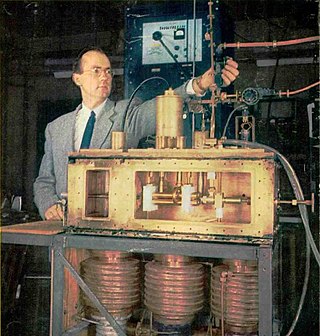
A maser is a device that produces coherent electromagnetic waves through amplification by stimulated emission. The first maser was built by Charles H. Townes, James P. Gordon, and Herbert J. Zeiger at Columbia University in 1953. Townes, Nikolay Basov and Alexander Prokhorov were awarded the 1964 Nobel Prize in Physics for theoretical work leading to the maser. Masers are also used as the timekeeping device in atomic clocks, and as extremely low-noise microwave amplifiers in radio telescopes and deep-space spacecraft communication ground stations.
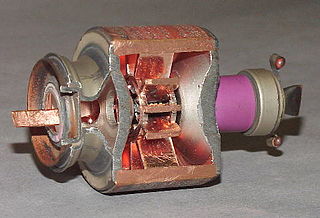
The cavity magnetron is a high-power vacuum tube used in early radar systems and currently in microwave ovens and linear particle accelerators. It generates microwaves using the interaction of a stream of electrons with a magnetic field while moving past a series of cavity resonators, which are small, open cavities in a metal block. Electrons pass by the cavities and cause microwaves to oscillate within, similar to the functioning of a whistle producing a tone when excited by an air stream blown past its opening. The resonant frequency of the arrangement is determined by the cavities' physical dimensions. Unlike other vacuum tubes, such as a klystron or a traveling-wave tube (TWT), the magnetron cannot function as an amplifier for increasing the intensity of an applied microwave signal; the magnetron serves solely as an oscillator, generating a microwave signal from direct current electricity supplied to the vacuum tube.
Beam-powered propulsion, also known as directed energy propulsion, is a class of aircraft or spacecraft propulsion that uses energy beamed to the spacecraft from a remote power plant to provide energy. The beam is typically either a microwave or a laser beam and it is either pulsed or continuous. A continuous beam lends itself to thermal rockets, photonic thrusters and light sails, whereas a pulsed beam lends itself to ablative thrusters and pulse detonation engines.
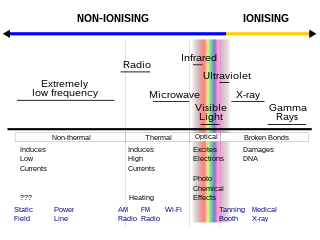
Electromagnetic radiation can be classified into two types: ionizing radiation and non-ionizing radiation, based on the capability of a single photon with more than 10 eV energy to ionize atoms or break chemical bonds. Extreme ultraviolet and higher frequencies, such as X-rays or gamma rays are ionizing, and these pose their own special hazards: see radiation poisoning.
The microwave auditory effect, also known as the microwave hearing effect or the Frey effect, consists of the human perception of audible clicks, or even speech, induced by pulsed or modulated radio frequencies. The communications are generated directly inside the human head without the need of any receiving electronic device. The effect was first reported by persons working in the vicinity of radar transponders during World War II. In 1961, the American neuroscientist Allan H. Frey studied this phenomenon and was the first to publish information on the nature of the microwave auditory effect. The cause is thought to be thermoelastic expansion of portions of the auditory apparatus, although competing theories explain the results of holographic interferometry tests differently.

A microwave oven is an electric oven that heats and cooks food by exposing it to electromagnetic radiation in the microwave frequency range. This induces polar molecules in the food to rotate and produce thermal energy in a process known as dielectric heating. Microwave ovens heat foods quickly and efficiently because excitation is fairly uniform in the outer 25–38 mm(1–1.5 inches) of a homogeneous, high-water-content food item.

The Federation of American Scientists (FAS) is an American nonprofit global policy think tank with the stated intent of using science and scientific analysis to attempt to make the world more secure. FAS was founded in 1946 by scientists who worked on the Manhattan Project to develop the first atomic bombs. The Federation of American Scientists states that it aims to reduce the amount of nuclear weapons that are in use, and prevent nuclear and radiological terrorism. It says it aims to present high standards for nuclear energy's safety and security, illuminate government secrecy practices, as well as track and eliminate the global illicit trade of conventional, nuclear, biological and chemical weapons. With 100 sponsors, the Federation of American Scientists says that it promotes a safer and more secure world by developing and advancing solutions to important science and technology security policy problems by educating the public and policy makers, and promoting transparency through research and analysis to maximize impact on policy. FAS projects are organized in three main programs: nuclear security, government secrecy, and biosecurity. FAS has played a role in the control of atomic energy and weapons, as well as better international monitoring of atomic activities.
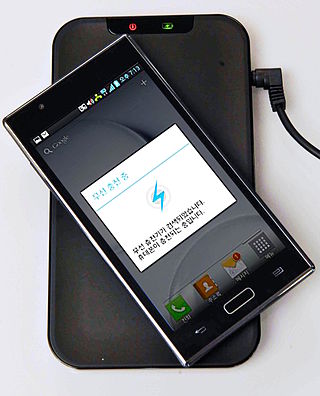
Wireless power transfer (WPT), wireless power transmission, wireless energy transmission (WET), or electromagnetic power transfer is the transmission of electrical energy without wires as a physical link. In a wireless power transmission system, a transmitter device, driven by electric power from a power source, generates a time-varying electromagnetic field, which transmits power across space to a receiver device, which extracts power from the field and supplies it to an electrical load. The technology of wireless power transmission can eliminate the use of the wires and batteries, thus increasing the mobility, convenience, and safety of an electronic device for all users. Wireless power transfer is useful to power electrical devices where interconnecting wires are inconvenient, hazardous, or are not possible.
The radio spectrum is the part of the electromagnetic spectrum with frequencies from 3 Hz to 3,000 GHz (3 THz). Electromagnetic waves in this frequency range, called radio waves, are widely used in modern technology, particularly in telecommunication. To prevent interference between different users, the generation and transmission of radio waves is strictly regulated by national laws, coordinated by an international body, the International Telecommunication Union (ITU).

The antennas contained in mobile phones, including smartphones, emit radiofrequency (RF) radiation ; the parts of the head or body nearest to the antenna can absorb this energy and convert it to heat. Since at least the 1990s, scientists have researched whether the now-ubiquitous radiation associated with mobile phone antennas or cell phone towers is affecting human health. Mobile phone networks use various bands of RF radiation, some of which overlap with the microwave range. Other digital wireless systems, such as data communication networks, produce similar radiation.

The Committee for a Constructive Tomorrow (CFACT) is a US-based 501(c)(3) nonprofit organization founded in 1985 that advocates for free-market solutions to environmental issues. According to its mission statement, CFACT also seeks to protect private property rights, promote economic policies that reduce pollution and protect wildlife, and provide an "alternative voice on issues of environment and development".

Space-based solar power is the concept of collecting solar power in outer space by solar power satellites (SPS) and distributing it to Earth. Its advantages include a higher collection of energy due to the lack of reflection and absorption by the atmosphere, the possibility of very little night, and a better ability to orient to face the sun. Space-based solar power systems convert sunlight to some other form of energy which can be transmitted through the atmosphere to receivers on the Earth's surface.
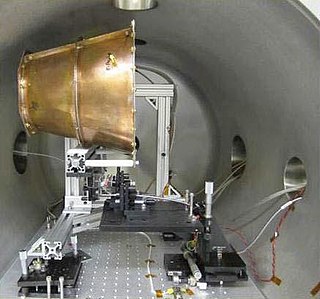
The EmDrive is a concept for a thruster for spacecraft, first written about in 2001. It is purported to generate thrust by reflecting microwaves inside the device, in a way that would violate the law of conservation of momentum and other laws of physics. The concept has been referred to at times as a resonant cavity thruster or as the latest Impossible Drive.
Robert Vincent Decareau was an American food scientist who was involved in the development of microwave applications in food technology, specifically technology that would lead to the development of the microwave oven. He also served in the United States Navy during World War II and in the United States Army during the Korean War. Decareau also was charter member of Phi Tau Sigma while pursuing his Ph.D. at the University of Massachusetts Amherst.
The Journal of Microwave Power and Electromagnetic Energy is a quarterly peer-reviewed scientific journal covering industrial, medical, and scientific applications of electromagnetic and microwaves from 0.1 to 100 GHz, including topics such as food processing, instrumentation, polymer technologies, and systems design.

American Hustle is a 2013 American historical black comedy crime film directed by David O. Russell. It was written by Eric Warren Singer and Russell, inspired by the FBI Abscam operation of the late 1970s and early 1980s. It stars Christian Bale and Amy Adams as two con artists who are forced by an FBI agent to set up an elaborate sting operation on corrupt politicians, including the mayor of Camden, New Jersey. Jennifer Lawrence plays the unpredictable wife of Bale's character. Principal photography took place from March to May 2013 in Boston and Worcester, Massachusetts as well as New York City.

Institute of Physics and Power Engineering is a research and development institute in the field of nuclear technology located in Obninsk, Russia. It is a subsidiary of Rosatom.

James Nelson Benford is an American physicist, High-Power Microwave (HPM) scientist, book author, science-fiction writer, and entrepreneur, best known for introducing novel technological concepts and conjectures related to the exploration of outer space, among these the design of laser-driven sailships, the possible use of co-orbital objects by alien probes to spy on earth, and the appraisal of technical and safety issues associated with the Search for Extraterrestrial Intelligence (SETI). He was born in Mobile, Alabama in 1941.
References
- ↑ Chaker, Anne Marie. "LYFE Kitchens, Evol and Others Want to Make TV Dinners Better". WSJ. Retrieved 2023-03-10.
- ↑ 'American Hustle’ Didn’t Get Its Microwave Facts Straight, Posted by Marc Silver of National Geographic Magazine on January 9, 2014, http://voices.nationalgeographic.com/2014/01/09/american-hustle-didnt-get-its-microwave-facts-straight/
- ↑ "About IMPI". International Microwave Power Institute. Retrieved 2022-10-14.